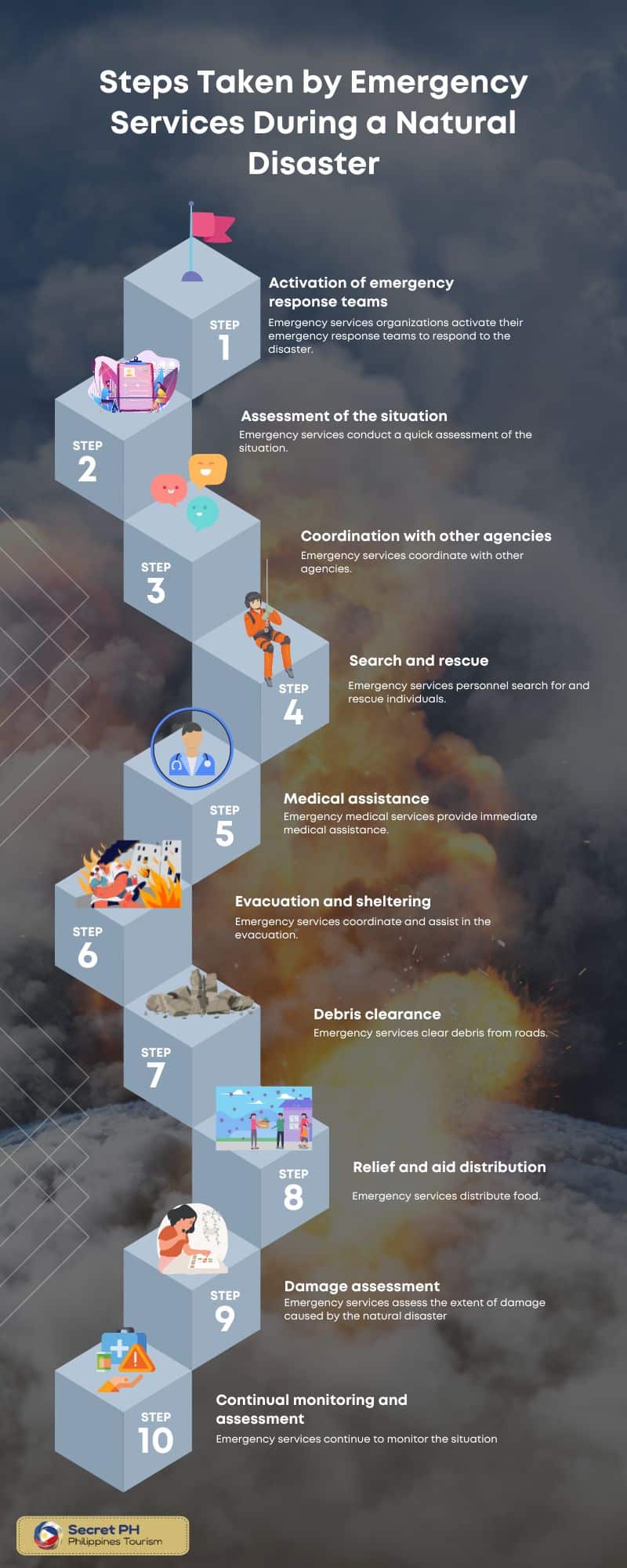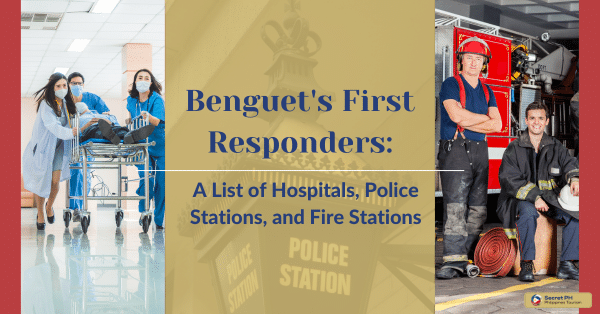Emergency services in the Philippines are key to responding effectively to natural disaster events. Natural disasters, such as typhoons, earthquakes, and floods, are a frequent occurrence in the Philippines. These organizations can ensure communities have the necessary resources to help extend support for those affected and assist in rebuilding efforts after a tragic event.
This blog post is dedicated to understanding the role of emergency services in natural disaster response in the Philippines, how they are currently organized and how they could be improved. By exploring these questions, we can continue to strive towards a more prepared and resilient country in responding to environmental crises.

Different Types of Natural Disasters Common in the Philippines
The Philippines is prone to various types of natural disasters due to its location in the Pacific Ring of Fire and its geographical makeup. Some of the most common natural disasters in the Philippines are:

Typhoon: Philippines is located in the Pacific typhoon belt and is hit by an average of 20 typhoons per year.
Floods: Due to heavy rainfall, flash floods are common in low-lying areas and river basins.
Earthquakes: Philippines is located in the Pacific Ring of Fire, making it prone to frequent earthquakes and volcanic eruptions.
Landslides: Philippines is a mountainous country, landslides are a common hazard during heavy rainfall and earthquakes.
Volcanic Eruptions: There are several active volcanoes in the Philippines, and eruptions can cause ashfall, lahars, and pyroclastic flows. These natural disasters can cause significant loss of life, damage to property and infrastructure, and displacement of communities.
The Role of Emergency Services
Emergencies can come in many forms, from natural disasters, to medical crises, or crime incidents. These services exist to respond quickly and efficiently to these life-threatening events with the necessary resources – whether that be paramedics, firefighters, police officers or military personnel. It requires a special kind of individual to be ready for any kind of situation no matter how extreme and have the capacity to respond appropriately.

Emergency Services Responses to Natural Disasters
The trained personnel of these organizations are on-site to assess the impact of the disaster, implement strategies for containment, and evaluate safety protocols for those affected. The severity of natural disasters can vary drastically but emergency services are prepared to respond accordingly no matter the circumstance.
Search and Rescue
Emergency services personnel search for and rescue individuals trapped or injured in the aftermath of a natural disaster.
Medical Assistance
Emergency medical services provide immediate medical assistance to those injured or in need of medical attention.
Evacuation and Sheltering
Emergency services coordinate and assist in the evacuation of affected communities and provide temporary shelter for those displaced.
Debris Clearance
Emergency services clear debris from roads, buildings, and other infrastructure to restore access and functionality.
Relief and Aid Distribution
Emergency services distribute food, water, and other necessities to affected communities.
Damage Assessment
Emergency services assess the extent of damage caused by the natural disaster and inform response and recovery efforts.
Steps Taken by Emergency Services During a Natural Disaster
During a natural disaster in the Philippines, emergency services take several steps to respond and assist affected communities. These steps include:

Activation of emergency response teams
Emergency services organizations activate their emergency response teams to respond to the disaster.
Assessment of the situation
Emergency services conduct a quick assessment of the situation to determine the extent of the damage and the needs of the affected communities.
Coordination with other agencies
Emergency services coordinate with other agencies, such as the national disaster agency, local government units, and other humanitarian organizations to ensure a coordinated response.
Search and rescue
Emergency services personnel search for and rescue individuals trapped or injured in the aftermath of the disaster.
Medical assistance
Emergency medical services provide immediate medical assistance to those injured or in need of medical attention.
Evacuation and sheltering
Emergency services coordinate and assist in the evacuation of affected communities and provide temporary shelter for those displaced.
Debris clearance
Emergency services clear debris from roads, buildings, and other infrastructure to restore access and functionality.
Relief and aid distribution
Emergency services distribute food, water, and other necessities to affected communities.
Damage assessment
Emergency services assess the extent of damage caused by the natural disaster and inform response and recovery efforts.
Continual monitoring and assessment
Emergency services continue to monitor the situation and assess the needs of affected communities throughout the response and recovery phases.
Examples of Emergency Services’ Response to Recent Disasters in the Philippines
There have been several recent natural disasters in the Philippines, and emergency services have played a critical role in responding to these events. Here are a few examples:
| DISASTER | EMERGENCY SERVICES’ RESPONSE |
| Typhoon Ulysses (2020) | Emergency services personnel and volunteers conducted search and rescue operations, evacuated affected communities, and provided medical assistance to those injured. They also distributed relief goods and provided temporary shelter to those displaced. |
| Taal Volcano Eruption (2020) | Emergency services assisted in the evacuation of over 300,000 people living near the volcano, providing medical assistance and temporary shelter to those affected. They also helped clear roads and infrastructure of volcanic ash and debris. |
| Super Typhoon Yolanda (2013) | Emergency services conducted search and rescue operations, evacuated affected communities, and provided medical assistance to those injured. They also distributed relief goods and provided temporary shelter to those displaced. |
| Mindanao Earthquake (2019) | Emergency services personnel and volunteers conducted search and rescue operations, evacuated affected communities, and provided medical assistance to those injured. They also distributed relief goods and provided temporary shelter to those displaced. |
Challenges faced by emergency services during natural disaster responses
Emergency services are an essential part of helping communities during natural disaster responses. While they strive to provide as much assistance as possible, they face many challenges that can impede their progress. These challenges range from limited resources due to financial constraints to communication difficulties when responding to disasters in remote and rural areas.
Limited Access to Remote and Isolated Areas
Accessing these areas can be extremely difficult, especially if the roads leading to them have been blocked or damaged by the disaster itself. Supplies may not be able to make it through and even personnel may find themselves unable to get in. Moreover, communications blackout due to lack of reception adds another layer of complexity into aid delivery. Planning ahead is critical as it allows emergency services personnel to effectively anticipate what resources will be available in order to save lives while ensuring everyone’s safety.

Lack of Funding and Resources
Lack of sufficient funding and resources can be one of the biggest challenges for emergency services during natural disaster responses, as allocating such necessary components to these services require a lot of financial backing.
Despite efforts from local, state, and federal governments as well as charitable groups, it is still difficult for emergency services to obtain the full range of available funds and resources needed when responding to natural disasters. This lack of support in addition to other limitations like an inability to forecast disasters creates an environment that is hard for emergency services personnel to respond despite their commitment and dedication.

Coordination and Communication Issues
Emergency responders must have the ability to work together and communicate with each other in order to effectively deal with a crisis situation. To overcome these issues, emergency services must have clear lines of communication and ensure that all relevant personnel are informed of the current situation.
Furthermore, to improve coordination efforts, emergency services should create detailed plans prior to a natural disaster occurring so that all participants know their respective roles and responsibilities when responding to the event.

Community Preparedness and Education
Community preparedness involves informing citizens about the hazards of the various disasters, developing strategies for evacuation and providing information on how to store water and food, among other topics. By equipping citizens with preventive knowledge, communities are more likely to rise to the challenges posed by natural disasters. To increase community preparedness and related education efforts, governments should partner with local non-profit organizations to engage citizens in active disaster drills.

Climate Change and Extreme Weather Events
Climate change and extreme weather events present several challenges to emergency services when it comes to responding and providing aid during natural disasters. Rising temperatures can lead to more frequent, intense, and long-lasting storms accompanied by strong winds, floods, and landslides. Challenges arise not only in the aftermath of natural disaster responses but also in developing their long-term strategies to reduce the impact of these catastrophic events.

In Conclusion
Emergency services play a critical role when natural disasters occur. During the event and in its aftermath, they provide safety to vulnerable victims, coordinate relief efforts, and protect property. In order to effectively juggle these responsibilities during times of crisis, emergency services must be well-trained, swift to respond, and exceptionally organized.
The leadership of emergency service personnel is crucial for the smooth operation of disaster response operations. Providing a stabilizing presence in the face of destruction that re-assures people of their safety is one key responsibility they must manage carefully.








